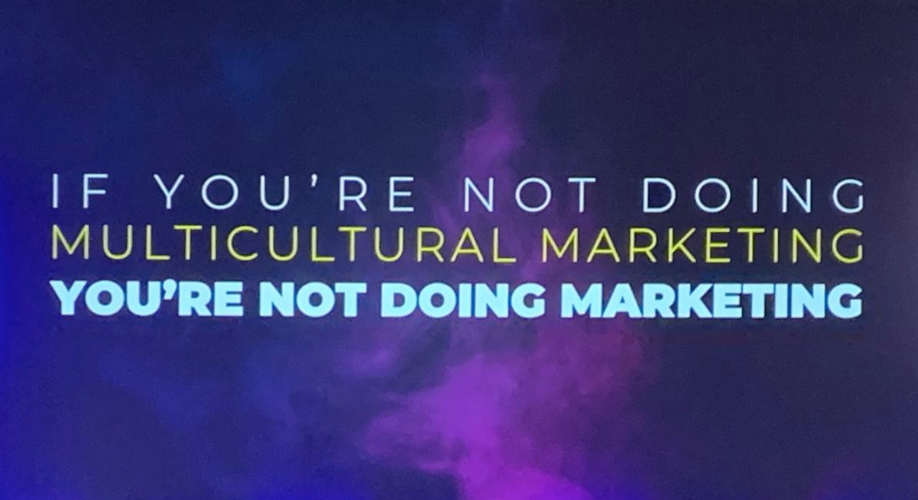I had the opportunity to attend the ANA Annual Multicultural Marketing and Diversity Conference in San Diego last month. Captura Group is proud to be an active member of the ANA working to elevate the importance of multicultural marketing for our own clients and the larger industry. As we head into 2020, I wanted to share some key takeaways from the conference that illuminate why multicultural marketing will become mainstream marketing next year.
- Multicultural is not a Segment. In many cases, multicultural market segments can make up 40% of a brand’s total consumer base. Based on this and a myriad of other facts, the marketing industry is waking up to the fact that in order to grow, brands must not pigeonhole multicultural into segments, placing them in silos and swim lanes, rather view multicultural as an imperative to integrate into a Total U.S. Growth Strategy. We should be well past the point where we need to build a case for investing in a market that a) is approaching half of the total today at a national level; b) already comprises the “minority majority in many DMA’s; and c) will make up much more into the future.
- Size the Prize and Then Right Size the Investment. Opportunity alert. Research demonstrates that brands are spending only 5% of their total media budgets on multicultural media while multicultural segments can represent 40% of the target audience universe. There is a clear opportunity for brands to speak to multicultural consumers who are otherwise being overlooked. Brands at the conference that are winning with multicultural consumers cited that the key to their success is having a long-term focus on multicultural markets that is supported by senior leadership. These successful brands are led by passionate individuals who clearly quantify the size of the prize today and tomorrow and, most importantly, allocate budgets that are commensurate with the opportunity.
- Test and Measure the Impact of Multicultural. We all know that marketing must demonstrate a quantifiable return on investment, and this is no different with multicultural marketing. After all, we can’t manage what we don’t measure. At Captura Group, one of the first components we prioritize within any multicultural marketing program is in setting up a holistic dashboard to help our clients measure across multiple KPIs. We heard the same from brands at the conference. Those driving growth with multicultural consumers are systematically integrating multicultural metrics into the way the entire organization measures success. The ANA has also led several initiatives to improve the ability for brands to surface culturally relevant insights, test creative and measure the impact of multicultural marketing. One example is the ANA AIMM’s new Cultural Insights Impact Measure™ (CIMM) which measures the impact of culturally led creative. Captura Group is proud to have participated in the initial pilot for CIMM and had a culturally relevant creative test in the top 25th percentile. We see this as rich validation for how insight-led creative drives better consumer response and how this response can be empirically measured.
- Integrate Multicultural Marketing with the Total Campaign Idea. There was a spirited discussion at the conference about the evolution of the “Total Market Approach”. Total Market varies from brand to brand, but most often it consists of campaigns that have an overarching commercial idea or brand truth that resonates with the the broad consumer landscape while allowing the expression of the brand truth to culturally and linguistically resonate with multicultural consumers. In this way, the campaign can achieve maximum impact and consistency, as it can engage all consumers across multiple touch points. This approach may mean that a brand expression or articulation may sound a bit nuanced or even different in order to be relevant to U.S. Hispanic, African-American and Asian-American [and many other] audiences – the point is that this is “all good” and reflective of what the total market has evolved to become.
- Get Comfortable Being Uncomfortable – Before we talk about culturally relevant creative, GRP’s, spillover, clicks or impressions, we need to focus on the human side of multicultural marketing – where competencies intersect with commitment. Many speakers at the conference made it clear that more marketers need to start having honest conversations about the diversity needed within their organizations (both internally and with agency partners) to reflect the markets they are pursuing for growth. But it doesn’t stop here. “Diversity” is getting invited to the party. “Inclusion” is getting asked to plan it and fully participate in it. The right balance of diversity and inclusion can help to overcome the unconscious biases and microaggressions that commonly create barriers to multicultural marketing success. Instead of merely saying “we want to grow with multicultural audiences,” marketers need to be prepared to change both their “thinking” and “doing” paradigms to start allowing differences to be celebrated, elevated and ultimately converted into marketing that connects with consumers on a deeply human level.
I wish you all a very happy holiday and hope these takeaways will inspire you to be part of the movement that drives multicultural marketing to become mainstream marketing. Here’s to a prosperous 2020!
